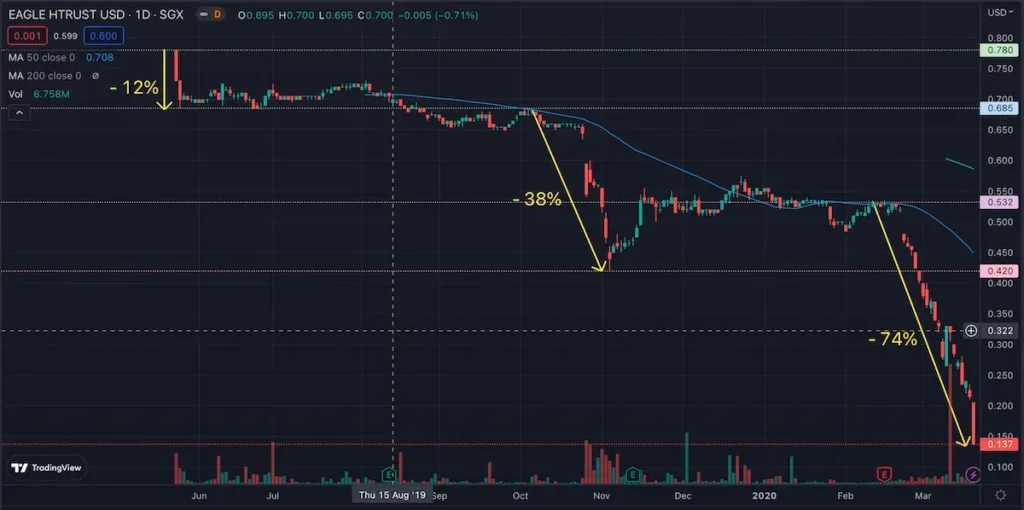Real Estate Investment Trusts or REITs have come a long way since the pioneers were listed on the New York Stock Exchange (NYSE) in the 1960s. Fast forward to today, according to the National Association of Real Estate Investment Trusts or Nareit, REITs have spread far and wide to more than 40 countries around the globe1.
Within Asia Pacific, you will likely find a good number of REITs with a solid track record listed on the stock exchanges of Australia, Hong Kong, Singapore and Japan.
Of course, since the birth of REITs, it hasn’t always been smooth sailing. I will never forget what happened in 2008 to 2009 during the Great Financial Crisis (GFC). REITs were not spared from the onslaught and many had to take drastic actions in order to survive (more on this later). The good news is, those who survived, emerged from the GFC stronger than ever.
If you are new to the universe of REITs, you would naturally wonder if REITs are a safe investment. The short answer is: Generally yes, provided you understand the risks and rewards involved.
This is exactly what this article is about. So rev your engine and get ready. Let’s take a close look at the four key risk factors associated with REITs:
By the way, if you are new to REITs, I would strongly recommend that you read How REITs work: Get Started on Real Estate Investing before diving into this one.
1. Leverage Risk
Debt flows through the veins of every REIT. In other words, a REIT is an investment vehicle that is fuelled by borrowed money. Leverage is part of its business model.
With a healthy level of leverage, the return on investment is optimised. Too little, returns degrade. Too much and the REIT faces jeopardy. So the question begs: how much leverage is considered healthy?
For Singapore REITs or S-REITs, the leverage limit was 45%. This was raised to 50% in 2020 to allow S-REITs more wiggle room to navigate through the COVID-19 pandemic.
The pandemic aside, general consensus seems to agree that a healthy (or safe) range measured using the gearing ratio (aka leverage ratio) should be below 45%. This would allow a REIT to have some leeway should it require to take on more debt to finance future acquisitions or ride out economic headwinds if valuations of its assets dip.

Let’s consider a hypothetical case of a REIT taking a loan of $480,000 on a property valued at $1,000,000. This translates to a gearing ratio of 48%.
Property value = $1,000,000 Debt = $480,000 Gearing ratio = $480,000/$1,000,000 x 100 = 48% Let’s say the property value drops by 10%: Property value = $900,000 (drops by 10%) Debt = $480,000 (remains the same, interest only loan) Gearing ratio = $480,000/$900,000 x 100 = 53% (50% limit breached!)
What the above numbers reveal is that a REIT is at risk of breaching its gearing limit should the value of its assets drop too much.
In good times, asset values appreciate. In bad times, the same can’t be said. Not too long ago, during the GFC in 2008, not only did asset prices take a nose dive, the credit market had frozen up — REITs were facing problems refinancing their debt. Everyone (not just REITs) were scrambling to secure whatever loans they could get their hands on.
From 2008 to 2009, in order to survive the turbulent market conditions, many S-REITs were forced to raise capital from their unit holders through a rights issue.
S-REITs such as CapitaLand Mall Trust, CapitaLand Commercial Trust, Mapletree Logistic Trust, Keppel REIT and Frasers Commercial Trust all conducted rights issues to essentially pare down debt to stay below the gearing limit.
The S-REIT that stuck out the most was CapitaLand Mall Trust (now merged with CapitaLand Commercial Trust to form CapitaLand Integrated Commercial Trust), which raised a whopping S$1.23 billion in 2009 from their unit holders.
Take heed that unit holders face share dilution and distribution per unit (DPU) reduction if they choose NOT to subscribe to a rights issue. So as a REIT investor, it’s prudent that you remain liquid should you need to subscribe to a rights issue.
Take heed that unit holders face share dilution and DPU reduction if they choose NOT to subscribe to a rights issue.
To find out how to avoid a personal liquidity crunch, do read Mrs Wow’s article The Retirement Bucket Strategy Demystified. This will ensure you always have enough cash to ride out bad times even in your retirement years.
The crux of the matter is that leverage is a double-edged sword and should never be taken lightly. Hence, you might want to think twice and dig deeper before investing in a REIT that has a gearing ratio too close to the ceiling.

2. Interest Rate Risk
As REITs typically use debt to finance their acquisition of property assets, they generally have a higher debt-to-equity ratio (or gearing ratio) compared to other types of investments. What this implies is that REITs are naturally exposed to interest rate risk.
The main concern is often associated with a rising interest rate environment (like the one we are in now). When interest rates get hiked, the cost of borrowing goes up. Higher financing costs translates to higher expenses.
When interest rates get hiked, the cost of borrowing goes up. Higher financing costs translates to higher expenses.
In a nutshell, higher interest rates mean less cash flow, less opportunity for growth or enhancement for the REIT, and ultimately less DPU for unit holders. So if you have been wondering why the stock prices of REITs were on a downtrend for the whole of 2022, you would have your answer by now.
Having said that, interest rate risk can be mitigated by a good REIT manager who uses fixed rate debt to lock in low interest rates for the long term. If done properly, a REIT with well-termed, well-structured debt would limit its exposure to higher interest rates in the near term.
On the flip side, if a REIT is poorly managed and unable to hedge against rising interest rates, be prepared for an arduous time. If the REIT has trouble making its debt payments at higher interest rates, the risk of default becomes very real.
At the end of the day, though interest rate risk can be real thorn in the flesh, the pain level can be effectively lowered by a competent REIT manager.
3. Concentration Risk
Next up is concentration risk. This is a big one and has caused more than just a few REITs to fall from grace (at least temporarily). In most cases, concentration risk often results in a drastic drop in rental income, which means lower DPU for unit holders.
So what is concentration risk? To put it simply, it’s when you put all your eggs into one basket. Drop that basket and all your eggs get broken. All is lost! Distribute your eggs into several baskets and if you drop any one basket, you still have most of your eggs intact. That’s essentially the strategy behind diversifying your investment portfolio to avoid catastrophic loss. The same applies to the property portfolio of any REIT.
Where REITs are concerned, concentration risk basically arises from:
- Geographical Concentration
- Sector Concentration
- Tenant Concentration
Geographical Concentration
Geographical concentration is when the property assets of a REIT is concentrated in a certain geographical area. This exposes the cluster of properties to changes in the regional economy and political situation within a country, if any.
Probably the best example I can think of happened not too long ago in 2019. It was during the protests in Hong Kong, when Festival Walk, a shopping mall located in Kowloon was badly vandalised by protestors. Images of broken glass panels throughout the mall with a giant Christmas tree set ablaze went viral over the Internet. At the end of the fiasco, Festival Walk had to shut its doors for more than two months to carry out repair works. It must have been quite a nightmare for both the landlord and tenants. Who could’ve ever foresaw this?

The owner of the shopping mall was none other than the former Mapletree North Asia Commercial Trust (MNACT), which has merged with Mapletree Commercial Trust (MCT) to form Mapletree Pan Asia Commercial Trust (MPACT).
Back then, although MNACT owned assets not just in Hong Kong, but also in other parts of China and Japan, Festival Walk contributed more than 60% of its revenue! That’s a huge concentration risk and all from just a single property location.
Needless to say, MNACT suffered a significant revenue decline and price drop during those tumultuous times. It’s safe to say that the merger of MNACT and MCT has definitely reduced concentration risk (amongst other benefits) for its unit holders.
Sector Concentration
Sector concentration is related to the concentration of a REIT’s assets within a particular property sector. For instance, during the COVID-19 pandemic, hospitality REITs were gravely affected bar none.
An example is CapitaLand China Trust or CLCT (f.k.a. CapitaLand Retail China Trust) which is currently the largest China-focused S-REIT. In 2020, when the COVID-19 pandemic broke out, CLCT was still a pure-play retail REIT that owned 13 shopping malls in densely populated tier 1 and 2 cities across China.
Like many other retail REITs, CLCT suffered during the lockdown in China, causing its share price to plunge by more than 30% from its peak. With everyone avoiding shopping malls, retail sales inevitably plummeted and CLCT’s revenue took a big hit. DPU has been choppy ever since.

Fast forward to 2023, although CLCT’s share price has yet to recover to pre-pandemic levels, the now diversified S-REIT is more resilient since it expanded its retail only portfolio to include five business parks and four logistics assets in 2021 (hence the name change). This decisive move by CapitaLand not only alleviates sector concentration risk, but also improves the growth prospects for CLCT down the road.
It will be interesting to see what happens this year, now that China has finally lifted its Zero-COVID policy. Will China come roaring back? Whatever the case, a worldwide recession seems imminent and the outlook at best remains uncertain.
Check out: Investing During a Recession: What You Need to Know
Tenant Concentration
REITs that have a high concentration of tenants from a single industry or trade will inevitably experience a decline in revenue and net property income (NPI) should the industry or trade go through a downturn or worse a complete collapse due to disruption.
REIT managers are highly aware of tenant concentration risk and often strive for a diverse mix of high quality tenants. Achieving the ideal tenant mix is no easy task. As such, having competent asset and property managers is paramount to the success of any REIT.
4. Market Risk
Last but not least, REITs are exposed to market risk. Putting aside the day-to-day price fluctuations, this ultimately means that the share price of a REIT can literally go to zero. Though unlikely, there is always the possibility. Case in point, let’s take a closer look at what happened to Eagle Hospitality Trust (EHT).

EHT held a portfolio of 18 hotels across nine states in the US. Its assets included the Westin Sacramento and the Queen Mary Long Beach. As seen in the price chart below, things went downhill from the very start, i.e. since EHT’s IPO on 24th May 2019. Within two days after it IPO-ed, its share price dropped by about 12%. Yikes!

Thereafter, EHT’s share price went sideways like a crab for another four months before plunging another 38%. In the last month of trading, its share price took a final nose dive of about 74% before trading was suspended on 19th March 2020.
On the day when trading was halted, EHT announced to its unit holders that it would abandon distribution payment to its unit holders. EHT had defaulted on a $341 million loan from the Bank of America.
Long story short, by January 2021, EHT and 27 of its subsidiaries had filed for Chapter 11 bankruptcy in the US. After most of EHT’s assets were liquidated six months later, creditors were still unable to fully recover their claims. Obviously, this didn’t bode well for EHT’s unit holders.
Whether the cause of EHT’s demise was due to the COVID-19 pandemic, poor judgement or mismanagement, the fact remains that many investors had lost their hard earned money. EHT’s example was cited in this article to drive home the point that investment risk is very real and needs be fully understood.
The bottom line is: there are no guarantees when it comes to investing in REITs or any other equity.
Having said that, there are of course, various ways to manage investment risk to the point where you can sleep soundly at night.
If you are keen to find out more, make sure to get notified of new posts by clicking on the bell icon (at the bottom right corner). I’ll be sharing how to pick the best REITs that suit your risk appetite in subsequent articles. So stay tuned!
Source:
- REITs Widen Their Global Reach: https://www.reit.com/news/reit-magazine/march-april-2022/reits-widen-their-global-reach
More like this: What Types of REITs are Available: A Beginner’s Guide | Understanding Retail REITs in Singapore: A Beginner’s Guide | Evaluating Retail REITs: The Numbers You Need to Know

